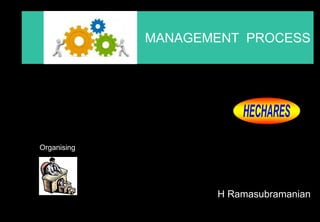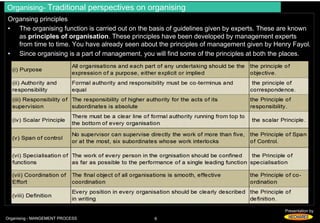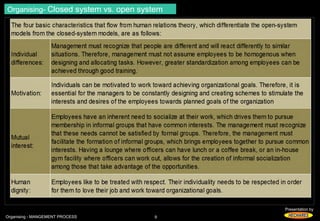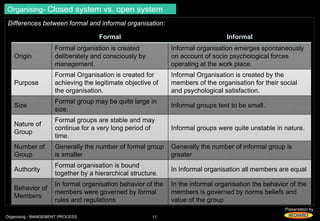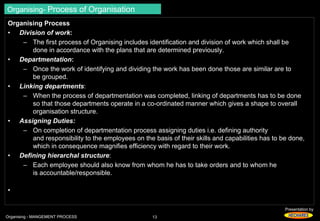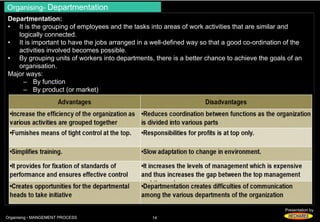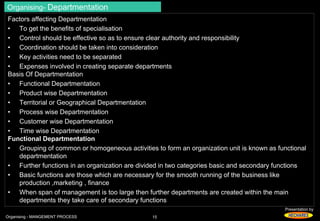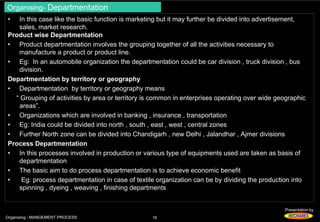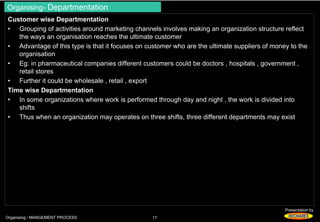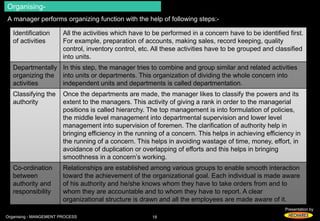Organising - MANAGEMENT PROCESS
- 1. MANAGEMENT PROCESS H Ramasubramanian Organising
- 2. Organising- Meaning and scope Organising • It is the function of management which follows planning. • It is a function in which the synchronisation and combination of human, physical and financial Presentation by resources takes place. • All the three resources are important to get results. • Therefore, organisational function helps in achievement of results which in fact is important for the functioning of a concern. • Organising is the process of defining and grouping activities and establishing authority relationships among them to attain organisational objectives Hence, a manager always has to organise in order to get results. Importance of Organising • Organising helps Organisations to reap the benefit of specialisation. • Organising provides for Optimum utilisation of resources. • Organising helps in Effective administration. • Organising channels for Expansion and growth. • Organising achieves co-ordination among different departments. • Organising creates scope for new change. Organising - MANGEMENT PROCESS 2
- 3. Presentation by Organising- Meaning and scope Organising - MANGEMENT PROCESS 3
- 4. Presentation by Organising- Traditional perspectives on organising • Traditional perspectives on organising: – View of Fayal, Taylor, Weber, etc; – Principles of organising; – challenging to the traditional view: – Bottomup authority, – environmental complexity and uncertainty. Organising - MANGEMENT PROCESS 4
- 5. Presentation by Organising- Traditional perspectives on organising Organising - MANGEMENT PROCESS 5
- 6. Organising- Traditional perspectives on organising Organsing principles • The organising function is carried out on the basis of guidelines given by experts. These are known as principles of organisation. These principles have been developed by management experts from time to time. You have already seen about the principles of management given by Henry Fayol. • Since organising is a part of management, you will find some of the principles at both the places. Presentation by Organising - MANGEMENT PROCESS 6
- 7. Organising- Closed system vs. open system Closed-System Models: The Classical Perspective • Closed-system models consider the external environment (technological advancements, the cultural and demographic characteristics of the community, legal decisions, political decisions, etc. to be stable and predictable. • They assume that it does not intervene in or cause problems for the functioning of an organization. • Therefore, the closed-system models do not depend on the external environment for explanations or solutions to managerial issues; instead, they are enclosed and sealed off from the outside world. • These models rely primarily on internal organizational processes and dynamics to account for Presentation by organizational, group, and individual behaviours. • The central management objective addressed in these models is the efficient running of the organization. • Closed systems are easier to deal with theoretically than open systems, and are preferred, despite their limitations. • For example, if abuse of prisoners took place in a certain prison, a closed-system approach would look for explanations for the abuse within the prison itself, and then adopt correctional procedures. The prison would examine the prison policies, prison warden, correctional officers, prison culture, officer–inmate interaction, inmate–inmate interaction, and other organizational components of the prison. • It would not pay attention to the external environment to identify the causes of the problems. • In other words, the external environment would not be blamed for the abuse. • The prison and its officials would assume that something within the facility led to these issues. Organising - MANGEMENT PROCESS 7
- 8. Organising- Closed system vs. open system Open-System Models: The Humanistic Perspective • Classical thinkers made significant contributions to the theory and practice of management. • However, their theories did not always achieve the desired results because they did not include the Presentation by behavioral perspective of management. • During the early 20th century, the industrialized nations of the world were experiencing social and cultural changes. • Their standards of living and working conditions were improving. • It was increasingly noted that the actions of management were not necessarily consistent with the ones predicted by the closed-system models. • More and more, human behaviour was being seen as an important factor in shaping managerial style and worker actions Revisiting the example of prisoner abuse that was discussed earlier under the closed-system model, an open-system approach would look for external reasons to explain the problem. Researchers may discover that the problem started 2 years back when the governor visited the state prison. In his speech, the governor mentioned reducing the budget for the prisons, which was not well received among the inmates. The conditions at that prison were already appalling. Any further cut in the budget was perceived by the inmates as implying a worsening of inmate privileges and security, making them angry and confrontational. Such defiant inmate behavior led to more hours of work for the correctional officers, who were already underpaid due to restrictive budgets. The officers became angry and resorted to dealing with the prisoners heavy-handedly, thus leading to abuse. Close examination of this example shows the interaction among an external stimulus, officers’ responses, and inmates’ (customer) reactions, all collectively interacting to create the chaos. Organising - MANGEMENT PROCESS 8
- 9. Presentation by Organising- Closed system vs. open system Organising - MANGEMENT PROCESS 9
- 10. Presentation by Organising- Formal & Informal Organisation Formal organisation: • It refers to the organisation structure deliberately created by management for achieving the objectives of enterprise. • It is a network of official authority responsibility relationships and communication follows. • It is an official and rational structure. • According to Chester Bernard, “Formal organisation is a system of consciously coordinated activities of two or more persons towards a common objectives. • The essence of formal organisation is conscious common purpose and formal organisation comes into existence when persons • (A) are able to communicate with each other • (B) are willing to act and • (C) share a purpose.” Informal Organisation: • It refers to the pattern of activity interactions and human relationship which emerge spontaneously due to social and psychological forces operating at the work place. • It arises naturally on the basis of friendship or some common interest which may or may not be related with work. • According to Chester Bernard, “ Informal organisation is joint personal activity with out conscious common purpose though contributing to joint result.” Organising - MANGEMENT PROCESS 10
- 11. Presentation by Organising- Closed system vs. open system Differences between formal and informal organisation: Formal Informal Origin Formal organistion is created deliberately and consciously by management. Organising - MANGEMENT PROCESS 11 Informal organisation emerges spontaneously on account of socio psychological forces operating at the work place. Purpose Formal Organisation is created for achieving the legitimate objective of the organisation. Informal Organisation is created by the members of the organisation for their social and psychological satisfaction. Size Formal group may be quite large in size. Informal groups tent to be small. Nature of Group Formal groups are stable and may continue for a very long period of time. Informal groups were quite unstable in nature. Number of Group Generally the number of formal group is smaller Generally the number of informal group is greater Authority Formal organisation is bound together by a hierarchical structure. In Informal organisation all members are equal Behavior of Members In formal organisation behavior of the members were governed by formal rules and regulations In the informal organisation the behavior of the members is governed by norms beliefs and value of the group
- 12. Presentation by Organising- Closed system vs. open system Differences between formal and informal organisation: Formal Informal Communication In formal organisation, communication normally flows through the prescribed chain of command. Organising - MANGEMENT PROCESS 12 In informal organisation communications pass through the informal channels. Abolition Management can abolish the formal groups at any time. Management has no control over informal groups which are the creation of natural desire of human beings to interact. Leadership In formal organisation, leadership is vested in managers. In informal organisation, leadership is not associated with managership. Status There are sharp status differentials among the members of formal organisation, which inhibit free interaction and socialisation. In informal organisation there may be social ranking among people but these do not prevent free interaction among people.
- 13. Presentation by Organising- Process of Organisation Organising Process • Division of work: – The first process of Organising includes identification and division of work which shall be done in accordance with the plans that are determined previously. • Departmentation: – Once the work of identifying and dividing the work has been done those are similar are to be grouped. • Linking departments: – When the process of departmentation was completed, linking of departments has to be done so that those departments operate in a co-ordinated manner which gives a shape to overall organisation structure. • Assigning Duties: – On completion of departmentation process assigning duties i.e. defining authority and responsibility to the employees on the basis of their skills and capabilities has to be done, which in consequence magnifies efficiency with regard to their work. • Defining hierarchal structure: – Each employee should also know from whom he has to take orders and to whom he is accountable/responsible. • Organising - MANGEMENT PROCESS 13
- 14. Organising- Departmentation Departmentation: • It is the grouping of employees and the tasks into areas of work activities that are similar and Presentation by logically connected. • It is important to have the jobs arranged in a well-defined way so that a good co-ordination of the activities involved becomes possible. • By grouping units of workers into departments, there is a better chance to achieve the goals of an organisation. Major ways: – By function – By product (or market) Organising - MANGEMENT PROCESS 14
- 15. Organising- Departmentation Factors affecting Departmentation • To get the benefits of specialisation • Control should be effective so as to ensure clear authority and responsibility • Coordination should be taken into consideration • Key activities need to be separated • Expenses involved in creating separate departments Basis Of Departmentation • Functional Departmentation • Product wise Departmentation • Territorial or Geographical Departmentation • Process wise Departmentation • Customer wise Departmentation • Time wise Departmentation Functional Departmentation • Grouping of common or homogeneous activities to form an organization unit is known as functional Presentation by departmentation • Further functions in an organization are divided in two categories basic and secondary functions • Basic functions are those which are necessary for the smooth running of the business like production ,marketing , finance • When span of management is too large then further departments are created within the main departments they take care of secondary functions Organising - MANGEMENT PROCESS 15
- 16. Organising- Departmentation • In this case like the basic function is marketing but it may further be divided into advertisement, Presentation by sales, market research. Product wise Departmentation • Product departmentation involves the grouping together of all the activities necessary to manufacture a product or product line. • Eg: In an automobile organization the departmentation could be car division , truck division , bus division. Departmentation by territory or geography • Departmentation by territory or geography means “ Grouping of activities by area or territory is common in enterprises operating over wide geographic areas”. • Organizations which are involved in banking , insurance , transportation • Eg: India could be divided into north , south , east , west , central zones • Further North zone can be divided into Chandigarh , new Delhi , Jalandhar , Ajmer divisions Process Departmentation • In this processes involved in production or various type of equipments used are taken as basis of departmentation • The basic aim to do process departmentation is to achieve economic benefit • Eg: process departmentation in case of textile organization can be by dividing the production into spinning , dyeing , weaving , finishing departments Organising - MANGEMENT PROCESS 16
- 17. Organising- Departmentation Customer wise Departmentation • Grouping of activities around marketing channels involves making an organization structure reflect Presentation by the ways an organisation reaches the ultimate customer • Advantage of this type is that it focuses on customer who are the ultimate suppliers of money to the organisation • Eg: in pharmaceutical companies different customers could be doctors , hospitals , government , retail stores • Further it could be wholesale , retail , export Time wise Departmentation • In some organizations where work is performed through day and night , the work is divided into shifts • Thus when an organization may operates on three shifts, three different departments may exist Organising - MANGEMENT PROCESS 17
- 18. All the activities which have to be performed in a concern have to be identified first. For example, preparation of accounts, making sales, record keeping, quality control, inventory control, etc. All these activities have to be grouped and classified into units. In this step, the manager tries to combine and group similar and related activities into units or departments. This organization of dividing the whole concern into independent units and departments is called departmentation. Once the departments are made, the manager likes to classify the powers and its extent to the managers. This activity of giving a rank in order to the managerial positions is called hierarchy. The top management is into formulation of policies, the middle level management into departmental supervision and lower level management into supervision of foremen. The clarification of authority help in bringing efficiency in the running of a concern. This helps in achieving efficiency in the running of a concern. This helps in avoiding wastage of time, money, effort, in avoidance of duplication or overlapping of efforts and this helps in bringing smoothness in a concern’s working. Relationships are established among various groups to enable smooth interaction toward the achievement of the organizational goal. Each individual is made aware of his authority and he/she knows whom they have to take orders from and to whom they are accountable and to whom they have to report. A clear organizational structure is drawn and all the employees are made aware of it. Presentation by Organising- A manager performs organizing function with the help of following steps:- Identification of activities Departmentally organizing the activities Classifying the authority Co-ordination between authority and responsibility Organising - MANGEMENT PROCESS 18

